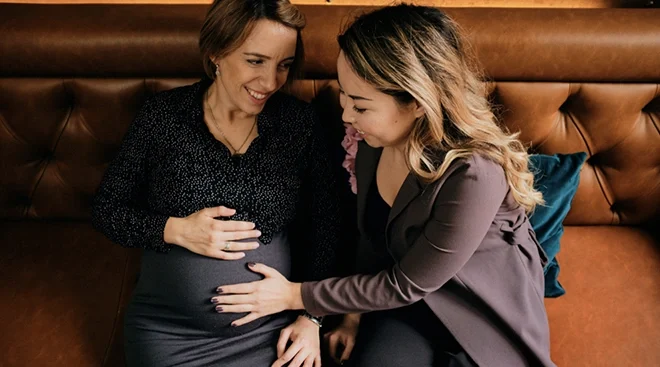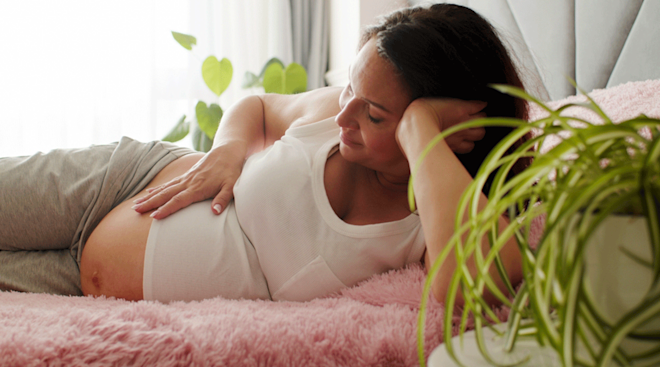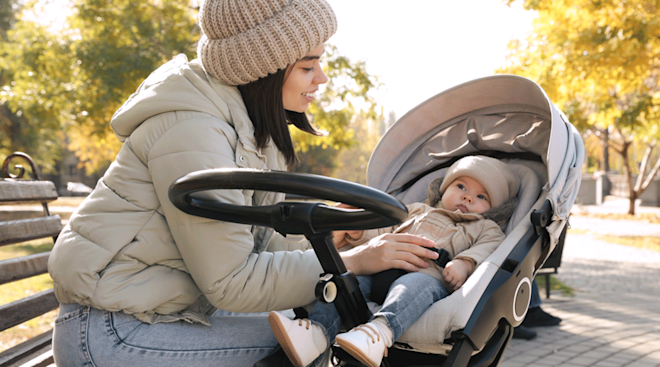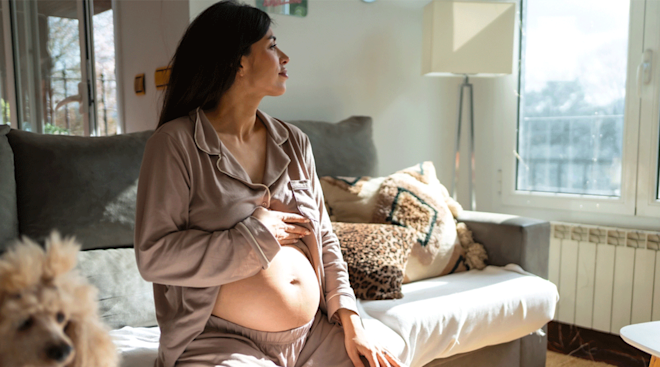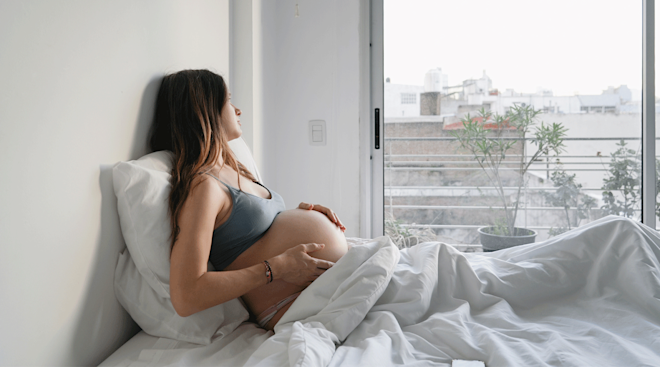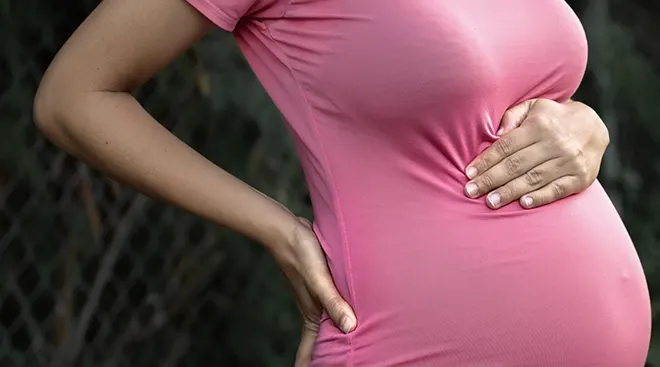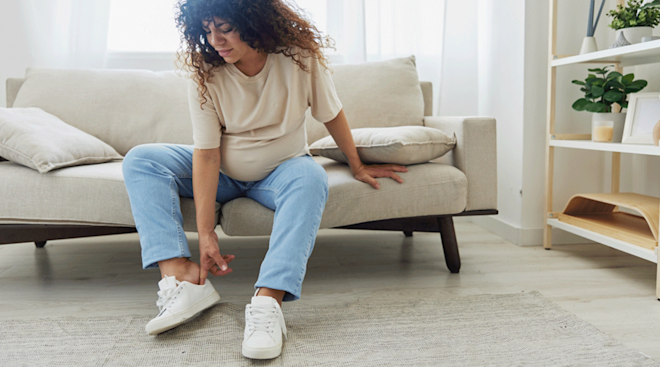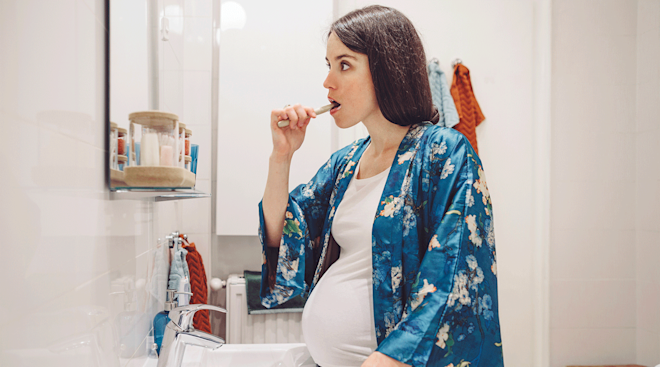When Can Other People Feel Baby Kick?
Feeling those first flutters of baby movement is a thrilling milestone for any mom-to-be. Sensing the growing life inside you lets you tune into your pregnancy in a totally new way—so it’s only natural to want to share that experience with your family and friends. But they’ll likely have to wait a while. So, when can other people feel baby kick? Keep reading to get answers from experts on when your partner or loved ones can feel and see baby kick from outside the pregnant belly.
Most women start feeling baby move sometime between 18 and 22 weeks, although some may feel it even earlier in their pregnancy, says Sara Twogood, MD, assistant professor of clinical obstetrics and gynecology at USC Keck School of Medicine in Los Angeles. In the beginning, those early kicks and rolls are often very subtle—in fact, they’re often indistinguishable from stomach gurgles and gas bubbles. “As the baby moves more frequently and women start registering fetal movement as distinct, they’ll often look back and say, ‘that was the baby moving, I just didn’t realize it at the time,’” Twogood says.
If baby’s early activity is tough for even the mom-to-be to pick up on, it’s likely the movements won’t be noticeable from outside the belly. That’ll change as your pregnancy progresses—but exactly when your loved ones and partner will feel baby kick can vary greatly from person to person (and pregnancy to pregnancy). For many, it’ll happen sometime between weeks 24 and 28, Twogood says, but that range can be as wide as 20 to 30 weeks. Generally, however, most loved ones can feel baby kick from the outside in the third trimester, adds Cynthia Flynn, MD, a Florida-based ob-gyn with JustAnswer.
Factors for when other people can feel baby move
Keep in mind that when it comes to seeing baby kick from outside, there are several factors that affect how well your partner and loved ones will be able to feel baby’s movement. These include:
-
Maternal weight. It may be harder for someone’s hand on the belly to detect a kicking baby if the mom-to-be is overweight or carries a little extra weight around their midsection, Twogood says, since the movement has to be stronger or more exaggerated to be felt on the outside.
-
Location of the placenta. If your placenta is located at the front of your uterus (known as an anterior placenta)—meaning it’s between baby and the wall of your belly—it can make it more difficult for others to feel baby’s kicks than if your placenta is tucked behind the uterus (called a posterior placenta), Twogood says.
-
Position of the baby. Sometimes it’s just a matter of waiting for baby to shift position for others to feel those kicks and jabs. If baby’s facing outward toward your belly, for example, it can be easier to notice those movements than if they’re facing inward toward your back, Flynn says.
What real moms say about feeling baby move from the outside
With such a wide range, it’s normal to wonder: When can others feel baby move? While it’s different for everyone, below, some Bump users and real moms offer their experience on when their loved ones felt baby’s movements:
-
“I would try and try to get my husband to feel the kicks and punches I was feeling for weeks, but every time he would put his hand on my belly the baby would stop. Finally at week 25 he felt a big one!” —Junebug9
-
“I think around 20 weeks my husband could really feel little jabs coming from my belly.” —Rosebride2006
-
“He finally felt her at 23 weeks, but he didn’t like to push on my belly and she didn’t always move when he was right there ready to feel. He really could feel her at 24 weeks.” —johnsoar
-
“Mine was 22 weeks. I didn’t realize what it was until I actually saw my tummy move, like somebody was poking me from the inside out.” —wiglsworth26
-
“About 23 weeks, because I have an anterior placenta (so it can take a little longer).” —joecubed
-
“My husband couldn’t feel her until about 27 weeks, although I had been feeling movement since around 17 weeks.” —mrsain1105
-
“I think around 23 weeks. He could feel little taps on his hand.” —wendyj
-
“My husband felt the baby for the first time right after we got back from our 20 week ultrasound.” —brandie_larue
-
“I don’t know why, but my husband could feel it very early (and me too, when I put my hand on my stomach)—at exactly 16 weeks.” —kmgourley
Wondering what you can do to help others feel those somersaults? There are a few ways to help other people feel baby kick from the outside—but most have to do with timing. Below, some expert tips on how to increase the chances of others feeling baby’s movements.
1. Pay attention to timing
Odds are your loved ones will best be able to feel baby’s kicks when they’re active. During the day, baby can be lulled to sleep by the movement of your daily routine, which is why when you settle in for the night, they often perk up. “Many babies move more in the evenings or at night, so this is when your partner should spend some time with their hand on your tummy,” says Mary Hirschi, CNM, a certified nurse midwife at Texas Children’s Pavilion for Women in Houston. You may already have a good idea of your little one’s activity through kick counts. Use this to time when your loved ones should try to feel baby’s kicks.
2. Help baby move in-utero
Even if you time it right, baby just might not be active when your loved ones try to feel them move. Luckily, you can try to encourage baby to kick. Flynn recommends lying on your left side rather than sitting. “This positions the uterus in a way that may make the baby more active and help others feel it more easily,” she says. Hirschi also recommends drinking something cold or sweet, like juice or ice water, a light massage or listening to music to help wake baby up and trigger some kicks.
3. Apply some pressure
As you feel baby moving, guide the person’s hand to the right spot on your belly—and don’t be afraid to let them softly push down. “It’s safe to apply gentle pressure to the abdomen, which may help people feel the baby more,” Twogood says. “If there’s a question of how much pressure is safe, ask your doctor to demonstrate at your next appointment.”
4. Don’t Give Up
It may be frustrating to have baby stop kicking the moment a loved one tries to feel it, but don’t get discouraged. Getting it down right away is almost an art, and it requires a lot of patience. “Sooner or later, the movements will also become visible to others from the outside, and baby will provide you both with some entertaining moments,” Hirschi says.
About the experts:
Sara Twogood, MD, FACOG, is a board-certified ob-gyn in Los Angeles and co-founder of Female Health Education. She’s also the author of Ladypartsblog.com, which covers topics relating to fertility and pregnancy, and the founder of FemEd, a program designed to empower females through health education.
Mary Hirschi, CNM, is a certified nurse midwife at Texas Children’s Pavilion for Women in Houston. She earned her medical degree from the University Of Southern California Keck School Of Medicine and has over 20 years of experience.
Cynthia Flynn, MD, is a board-certified ob-gyn based in Florida with over 20 years of experience. She is also an expert with the online platform JustAnswer. She received her degree from the Michigan State University College of Human Medicine.
Please note: The Bump and the materials and information it contains are not intended to, and do not constitute, medical or other health advice or diagnosis and should not be used as such. You should always consult with a qualified physician or health professional about your specific circumstances.
Plus, more from The Bump:
Navigate forward to interact with the calendar and select a date. Press the question mark key to get the keyboard shortcuts for changing dates.
































